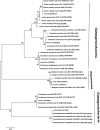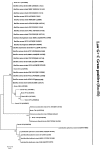Molecular characterization and amplified ribosomal DNA restriction analysis of entomopathogenic bacteria associated with Rhabditis (Oscheius) spp
- PMID: 28330100
- PMCID: PMC4713396
- DOI: 10.1007/s13205-015-0326-1
Molecular characterization and amplified ribosomal DNA restriction analysis of entomopathogenic bacteria associated with Rhabditis (Oscheius) spp
Abstract
Bacterial strains associated with entomopathogenic nematodes (EPNs) Rhabditis (Oscheius) spp. were isolated from infected cadavers of Galleria mellonella. The obtained 18 isolates were subdivided into nine phylogenetically different genera based on comparative sequence analysis of their 16S rRNA genes. The isolates were affiliated to three different class namely γ-proteobacteria (Enterobacter, Proteus, Providencia, Pseudomonas, Stenotrophomonas), β-proteobacteria (Alcaligenes) and Bacilli (Bacillus, Enterococcus, Lysinibacillus). It was observed that Gram-positive strains (Bacilli) were more frequently associated with the EPN, whereas Gram-negative isolates were affiliated to six different genera with more genotypic diversity. Subsequently, all bacterial isolates used in this study were analyzed by amplified ribosomal DNA restriction analysis (ARDRA). Eight restriction endonucleases (CfoI, HinfI, RsaI, DdeI, Sau3AI, AluI, HaeIII, and MspI) were examined and a total of 15 different genotypes were obtained, forming two heterogenous main clusters after analysis by un-weighted pair-group method using arithmetic averages.
Keywords: 16S rDNA; Bacillus; Enterobacter; Entomopathogenic nematode.
Conflict of interest statement
The authors declare that they have no conflict of interest in the publication.
Figures





Similar articles
-
Assessment of bacterial diversity in agricultural by-product compost by sequencing of cultivated isolates and amplified rDNA restriction analysis.Appl Microbiol Biotechnol. 2013 Aug;97(15):6991-7003. doi: 10.1007/s00253-012-4434-0. Epub 2012 Oct 6. Appl Microbiol Biotechnol. 2013. PMID: 23053087
-
Fast and accurate identification of Xenorhabdus and Photorhabdus species by restriction analysis of PCR-amplified 16S rRNA genes.Appl Environ Microbiol. 1997 Feb;63(2):574-80. doi: 10.1128/aem.63.2.574-580.1997. Appl Environ Microbiol. 1997. PMID: 9023937 Free PMC article.
-
Genetic diversity of siderophore-producing bacteria of tobacco rhizosphere.Braz J Microbiol. 2009 Apr;40(2):276-84. doi: 10.1590/S1517-838220090002000013. Epub 2009 Jun 1. Braz J Microbiol. 2009. PMID: 24031358 Free PMC article.
-
Insect pathogens as biological control agents: Back to the future.J Invertebr Pathol. 2015 Nov;132:1-41. doi: 10.1016/j.jip.2015.07.009. Epub 2015 Jul 27. J Invertebr Pathol. 2015. PMID: 26225455 Review.
-
Phylogenetic characterization of bacteria in the subsurface microbial culture collection.FEMS Microbiol Rev. 1997 Jul;20(3-4):201-16. doi: 10.1111/j.1574-6976.1997.tb00309.x. FEMS Microbiol Rev. 1997. PMID: 9299704 Review.
Cited by
-
Molecular characterization and PCR-based screening of cry genes from Bacillus thuringiensis strains.3 Biotech. 2017 May;7(1):4. doi: 10.1007/s13205-016-0583-7. Epub 2017 Apr 8. 3 Biotech. 2017. PMID: 28391468 Free PMC article.
-
Preliminary Screening on Antibacterial Crude Secondary Metabolites Extracted from Bacterial Symbionts and Identification of Functional Bioactive Compounds by FTIR, HPLC and Gas Chromatography-Mass Spectrometry.Molecules. 2024 Jun 19;29(12):2914. doi: 10.3390/molecules29122914. Molecules. 2024. PMID: 38930979 Free PMC article.
-
Evaluation and entomopathogenicity of gut bacteria associated with dauer juveniles of Oscheius chongmingensis (Nematoda: Rhabditidae).Microbiologyopen. 2019 Sep;8(9):e00823. doi: 10.1002/mbo3.823. Epub 2019 Mar 27. Microbiologyopen. 2019. PMID: 30916451 Free PMC article.
-
Genomic analysis of the nomenclatural type strain of the nematode-associated entomopathogenic bacterium Providencia vermicola.BMC Genomics. 2021 Oct 2;22(1):708. doi: 10.1186/s12864-021-08027-w. BMC Genomics. 2021. PMID: 34598677 Free PMC article.
-
Entomopathogenic potential of bacteria associated with soil-borne nematodes and insect immune responses to their infection.PLoS One. 2023 Jan 23;18(1):e0280675. doi: 10.1371/journal.pone.0280675. eCollection 2023. PLoS One. 2023. PMID: 36689436 Free PMC article.
References
-
- Akhurst RJ (1996) From then to now—a brief review of entomopathogenic nematodes and their symbiotic bacteria. In: Second international symposium on entomopathogenic nematodes and their symbiotic bacteria, pp 3–8
-
- Akhurst RJ, Boemare NE. Biology and taxonomy of Xenorhabdus. In: Gaugler R, Kaya H, editors. Entomopathogenic nematodes in biological control. Boca Raton: CRC Press Inc; 1990. pp. 75–90.
-
- Boemare NE, Akhurst RJ. Biochemical and physiological characterization of colony form variants in Xenorhabdus spp. (Enterobacteriaceae) J Gen Microbiol. 1988;134:751–761. - PubMed
-
- Boemare NE, Akhurst RJ, Mourant RG. DNA relatedness between Xenorhabdus spp. (Enterobacteriaceae), symbiotic bacteria of entomopathogenic nematodes, and a proposal to transfer Xenorhabdus luminescens to a new genus, Photorhabdus gen. nov. Int J Syst Evol Microbiol. 1993;43:249–255.
LinkOut - more resources
Full Text Sources
Other Literature Sources
Molecular Biology Databases
Miscellaneous

